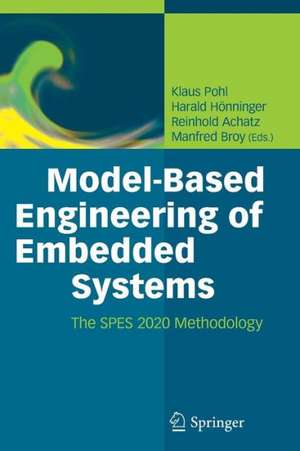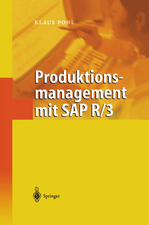Model-Based Engineering of Embedded Systems: The SPES 2020 Methodology
Editat de Klaus Pohl, Harald Hönninger, Reinhold Achatz, Manfred Broyen Limba Engleză Paperback – 14 dec 2014
This book provides a comprehensive overview of the Software Platform Embedded Systems (SPES) modeling framework and demonstrates its applicability in embedded system development in various industry domains such as automation, automotive, avionics, energy, and healthcare. In SPES 2020, twenty-one partners from academia and industry have joined forces in order to develop and evaluate in different industrial domains a modeling framework that reflects the current state of the art in embedded systems engineering.
The content of this book is structured in four parts. Part I “Starting Point” discusses the status quo of embedded systems development and model-based engineering, and summarizes the key requirements faced when developing embedded systems in different application domains. Part II “The SPES Modeling Framework” describes the SPES modeling framework. Part III “Application and Evaluation of the SPES Modeling Framework” reports on the validation steps taken to ensure that the framework met the requirements discussed in Part I. Finally, Part IV “Impact of the SPES Modeling Framework” summarizes the results achieved and provides an outlook on future work.
The book is mainly aimed at professionals and practitioners who deal with the development of embedded systems on a daily basis. Researchers in academia and industry may use it as a compendium for the requirements and state-of-the-art solution concepts for embedded systems development.
| Toate formatele și edițiile | Preț | Express |
|---|---|---|
| Paperback (1) | 313.76 lei 17-23 zile | +27.87 lei 7-13 zile |
| Springer Berlin, Heidelberg – 14 dec 2014 | 313.76 lei 17-23 zile | +27.87 lei 7-13 zile |
| Hardback (1) | 512.06 lei 6-8 săpt. | |
| Springer Berlin, Heidelberg – 9 noi 2012 | 512.06 lei 6-8 săpt. |
Preț: 313.76 lei
Preț vechi: 392.20 lei
-20% Nou
Puncte Express: 471
Preț estimativ în valută:
60.04€ • 62.91$ • 49.63£
60.04€ • 62.91$ • 49.63£
Carte disponibilă
Livrare economică 18-24 martie
Livrare express 08-14 martie pentru 37.86 lei
Preluare comenzi: 021 569.72.76
Specificații
ISBN-13: 9783642439926
ISBN-10: 3642439926
Pagini: 316
Ilustrații: XII, 304 p.
Dimensiuni: 168 x 240 x 17 mm
Greutate: 0.53 kg
Ediția:2012
Editura: Springer Berlin, Heidelberg
Colecția Springer
Locul publicării:Berlin, Heidelberg, Germany
ISBN-10: 3642439926
Pagini: 316
Ilustrații: XII, 304 p.
Dimensiuni: 168 x 240 x 17 mm
Greutate: 0.53 kg
Ediția:2012
Editura: Springer Berlin, Heidelberg
Colecția Springer
Locul publicării:Berlin, Heidelberg, Germany
Public țintă
Professional/practitionerCuprins
Part I Starting Situation.- Challenges in Engineering for Software-Intensive Embedded Systems.- Requirements from the Application Domains.- Part II The SPES Modeling Framework.- Introduction to the SPES Modeling Framework.- Requirements Viewpoint.- Functional Viewpoint.- Logical Viewpoint.- Technical Viewpoint.- Modeling Quality Aspects: Safety.- Modeling Quality Aspects: Real-Time.- Part III Application and Evaluation of the SPES Modeling Framework.- Overview of the SPES Evaluation Strategy.- Application and Evaluation in the Automation Domain.- Application and Evaluation in the Automotive Domain.- Application and Evaluation in the Avionics Domain.- Application and Evaluation in the Energy Domain.- Application and Evaluation in the Healthcare Domain.- Evaluation Summary.- Part IV Impact of the SPES Modeling Framework.- Lessons Learned.- Outlook.
Notă biografică
Klaus Pohl is full professor for Software Systems Engineering at the Institute of Computer Science and Business Computing of the University of Duisburg-Essen in Germany, and director of paluno – The Ruhr Institute for Software Technology. He was scientific founding director of Lero, the Irish Software Engineering Institute, served as coordinator of the FP7 Network of Excellence S-Cube (Software Services and Systems Network) and is member of several steering committees and boards of directors including the European Technology Platform NESSI (Networked European Software and Services Initiative) and the German Innovation Alliance SPES 2020.
Harald Hönninger is Vice President of Advance Engineering for Software-Intensive Systems at Corporate Research and Advanced Development with Robert Bosch GmbH. In his position, he is responsible for the pre-development of software-intensive systems and for corporate-wide software-, hardware- and systems engineering methods.
Reinhold Achatz recently joined ThyssenKrupp, where he leads the Corporate Center Technology, Innovation & Quality. Before he was Corporate Vice President of Siemens AG and head of Corporate Research and Technologies as well as the Corporate Development Center. He has been honored as a “Siemens Top Innovator” for his outstanding innovations in software-based components for set-up, operations and execution accuracy of machine tools.
Manfred Broy is full professor for Software and Systems Engineering at the Institute for Computer Science of the Technical University of Munich. Among other awards, he received the Leibniz Preis, the highest scientific award of the Federal Republic of Germany, the Order of Merit of the Federal Republic of Germany and the Konrad-Zuse-Medal for extraordinary services in Computer Science. Manfred Broy is a Max-Planck-Fellow, member of the German Academy of Science and Engineering and member of the German National Academy of the Sciences“Leopoldina”.
Harald Hönninger is Vice President of Advance Engineering for Software-Intensive Systems at Corporate Research and Advanced Development with Robert Bosch GmbH. In his position, he is responsible for the pre-development of software-intensive systems and for corporate-wide software-, hardware- and systems engineering methods.
Reinhold Achatz recently joined ThyssenKrupp, where he leads the Corporate Center Technology, Innovation & Quality. Before he was Corporate Vice President of Siemens AG and head of Corporate Research and Technologies as well as the Corporate Development Center. He has been honored as a “Siemens Top Innovator” for his outstanding innovations in software-based components for set-up, operations and execution accuracy of machine tools.
Manfred Broy is full professor for Software and Systems Engineering at the Institute for Computer Science of the Technical University of Munich. Among other awards, he received the Leibniz Preis, the highest scientific award of the Federal Republic of Germany, the Order of Merit of the Federal Republic of Germany and the Konrad-Zuse-Medal for extraordinary services in Computer Science. Manfred Broy is a Max-Planck-Fellow, member of the German Academy of Science and Engineering and member of the German National Academy of the Sciences“Leopoldina”.
Textul de pe ultima copertă
Embedded systems have long become essential in application areas in which human control is impossible or infeasible. The development of modern embedded systems is becoming increasingly difficult and challenging because of their overall system complexity, their tighter and cross-functional integration, the increasing requirements concerning safety and real-time behavior, and the need to reduce development and operation costs.
This book provides a comprehensive overview of the Software Platform Embedded Systems (SPES) modeling framework and demonstrates its applicability in embedded system development in various industry domains such as automation, automotive, avionics, energy, and healthcare. In SPES 2020, twenty-one partners from academia and industry have joined forces in order to develop and evaluate in different industrial domains a modeling framework that reflects the current state of the art in embedded systems engineering.
The content of this book is structured in four parts. Part I “Starting Point” discusses the status quo of embedded systems development and model-based engineering, and summarizes the key requirements faced when developing embedded systems in different application domains. Part II “The SPES Modeling Framework” describes the SPES modeling framework. Part III “Application and Evaluation of the SPES Modeling Framework” reports on the validation steps taken to ensure that the framework met the requirements discussed in Part I. Finally, Part IV “Impact of the SPES Modeling Framework” summarizes the results achieved and provides an outlook on future work.
The book is mainly aimed at professionals and practitioners who deal with the development of embedded systems on a daily basis. Researchers in academia and industry may use it as a compendium for the requirements and state-of-the-art solution concepts for embedded systems development.
This book provides a comprehensive overview of the Software Platform Embedded Systems (SPES) modeling framework and demonstrates its applicability in embedded system development in various industry domains such as automation, automotive, avionics, energy, and healthcare. In SPES 2020, twenty-one partners from academia and industry have joined forces in order to develop and evaluate in different industrial domains a modeling framework that reflects the current state of the art in embedded systems engineering.
The content of this book is structured in four parts. Part I “Starting Point” discusses the status quo of embedded systems development and model-based engineering, and summarizes the key requirements faced when developing embedded systems in different application domains. Part II “The SPES Modeling Framework” describes the SPES modeling framework. Part III “Application and Evaluation of the SPES Modeling Framework” reports on the validation steps taken to ensure that the framework met the requirements discussed in Part I. Finally, Part IV “Impact of the SPES Modeling Framework” summarizes the results achieved and provides an outlook on future work.
The book is mainly aimed at professionals and practitioners who deal with the development of embedded systems on a daily basis. Researchers in academia and industry may use it as a compendium for the requirements and state-of-the-art solution concepts for embedded systems development.
Caracteristici
Applies and transfers state-of-the-art model-based software development to industrial application Reports on experiences with model-based embedded systems development in application areas like automation, automotive, avionics, energy, and healthcare Combines experiences from leading academic institutions and European top 50 companies like Airbus Industries, Bosch, EADS, RWE and Siemens Includes supplementary material: sn.pub/extras



















